Your assigned line passes through the origin, its parametric equation is
x = u cos(a)
y = u sin(a)
and you can see the parameter u is simply the (oriented) distance beteween the origin and a point on the assigned line.
Now, consider a point of coordinates X and Y, a line perpendicular to the assigned one has the parametric equation
x = X - v sin(a)
y = Y + v cos(a)
and again, the parameter v is simply the (oriented) distance between (X, Y) and a point on a line passing per (X, Y) and perpendicular to the assigned one.
The intersection is given by the equation
X = u cos(a) + v sin(a)
Y = u sin(a) - v cos(a)
you can check by inspection that the solution of the system is
u = X cos(a) + Y sin(a)
v = X sin(a) - Y cos(a)
The distance of the point (X, Y) from the assigned line is hence
d = | X sin(a) - Y cos(a) |
A Python Implementation

import numpy as np
import matplotlib.pyplot as plt
np.random.seed(20221126)
X = 2*np.random.random(32)-1
Y = 2*np.random.random(32)-1
fig, ax = plt.subplots()
ax.set_xlim((-1.2, 1.2))
ax.set_ylim((-1.2, 1.2))
ax.grid(1)
ax.set_aspect(1)
ax.scatter(X, Y, s=80, ec='k', color='y')
a = 2*np.random.random()*np.pi
s, c = np.sin(a), np.cos(a)
plt.plot((0, c), (0, s), color='k')
plt.plot((-s, s), (c, -c), color='r')
# strike out "bad" points
bad = X*c+Y*s<0
plt.scatter(X[bad], Y[bad], marker='x', color='k')
# consider only good (i.e., not bad) points
Xg, Yg = X[~bad], Y[~bad]
# compute all distances (but for good points only)
d = np.abs(Xg*s-Yg*c)
# find the nearest point and hilight it
imin = np.argmin(d)
plt.scatter(Xg[imin], Yg[imin], ec='k', color='r')
plt.show()
An OVERDONE Example

import numpy as np
import matplotlib.pyplot as plt
np.random.seed(20221126)
X = 2*np.random.random(32)-1
Y = 2*np.random.random(32)-1
fig, axs = plt.subplots(2, 4, figsize=(10,5), layout='constrained')
for ax, a in zip(axs.flat,
(2.8, 1.8, 1.4, 0.2,
3.4, 4.5, 4.9, 6.0)):
ax.set_xlim((-1.2, 1.2))
ax.set_xticks((-1, -0.5, 0, 0.5, 1.0))
ax.set_ylim((-1.2, 1.2))
ax.grid(1)
ax.set_aspect(1)
ax.set_title('$\\alpha \\approx %d^o$'%round(np.rad2deg(a)))
ax.scatter(X, Y, s=80, ec='k', color='yellow')
s, c = np.sin(a), np.cos(a)
ax.arrow(0, 0, 1.2*c, 1.2*s, fc='k',
length_includes_head=True,
head_width=0.08, head_length=0.1)
# divide the drawing surface in two semiplanes
if abs(c)>abs(s):
if c>0:
ax.plot((1.2*s, -1.2*s), (-1.2, 1.2))
else:
ax.plot((-1.2*s, 1.2*s), (-1.2, 1.2))
elif abs(s)>=abs(c):
if s>0:
ax.plot((-1.2, 1.2), (1.2*c, -1.2*c))
else:
ax.plot((-1.2, 1.2), (-1.2*c, 1.2*c))
# strike out "bad" points
bad = X*c+Y*s<0
ax.scatter(X[bad], Y[bad], marker='x', color='k')
# consider only good (i.e., not bad) points
Xg, Yg = X[~bad], Y[~bad]
# compute all distances (but for good points only)
d = np.abs(Xg*s-Yg*c)
# find the nearest point and hilight it
imin = np.argmin(d)
ax.scatter(Xg[imin], Yg[imin], s=80, ec='k', color='yellow')
ax.scatter(Xg[imin], Yg[imin], s= 10, color='k', alpha=1.0)
plt.show()


